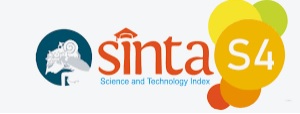Evaluasi User Experience Dan User Interface Aplikasi Laporkitong Dengan End User Computing Satisfaction
Abstract
The Lapor Kitong website has been around since 2022, but it is necessary to evaluate the User Experience and User Interface (UI/UX) to ensure optimal use of this platform. The study aims to determine the level of satisfaction of UI/UX with the LAPORKITONG application, by utilizing the End User Computing Satisfaction (EUCS) method which is measured using Partial Least Square Structural Equation Modeling (PLS-SEM). By distributing online questionnaires for two months, 168 valid respondents using the application were obtained. The results of the analysis show that of the five factors determining the level of satisfaction measured, only accuracy and ease of use have a statistically significant effect on the level of satisfaction with using the application. However, the results of the coefficient of determination (R)2 show that the independent variables used are quite significant in predicting the satisfaction level, namely 68.4%. This show that the need for the level of accuracy and ease of use of the platform is something that is of great concern and determines the experience of using it for the people of West Papua.
Keywords: Laporkitong; User Experience; User Interface; End User Computing Satisfaction; Partial Least Square Structural Equation Modeling
Â
Abstrak
Website Lapor Kitong sudah ada semenjak tahun 2022, namun perlu dilakukan evaluasi terhadap User Experience dan User Interface (UI/UX) untuk memastikan penggunaan platform ini semakin optimal. Penelitian ini bertujuan untuk mengetahui tingkat kepuasan (satisfaction) UI/UX terhadap aplikasi LAPORKITONG, dengan metode End User Computing Satisfaction (EUCS) diukur menggunakan Partial Least Square Structural Equation Modelling (PLS-SEM). Penyebaran kuesioner online dilakukan dua bulan dan 168 responden pengguna aplikasi tersebut yang valid. Hasil analisis dari lima faktor penentu tingkat kepuasan yang diukur, hanya accuracy dan ease of use yang berpengaruh signifikat terhadap tingkat kepuasan penggunaan. Hasil coefficient of determination (R)2 menunjukkan variabel–variabel independen yang digunakan cukup signifikan memprediksi satisfaction level, yaitu sebesar 68,4%. Hal ini menunjukkan bahwa kebutuhan tingkat akurasi dan kemudahan penggunaan platform tersebut menjadi hal yang sangat diperhatikan dan menentukan pengalaman penggunaannya bagi masyarakat Papua Barat.
Â
Keywords
References
A. Fitriansyah and I. Harris, “Pengukuran Kepuasan Pengguna Situs Web Dengan Metode End User Computing Satisfaction (EUCS)â€, Query Jurnal Sistem Informasi, Vol. 2, No. 1, pp. 1–8, 2018.
I. Kurniasih and Pibriana, “Pengaruh Kepuasan Pengguna Aplikasi Belanja Online Berbasis Mobile Menggunakan Metode EUCSâ€, JATISI (Jurnal Teknik Informatika dan Sistem Informasi), Vol.8, No. 1, pp. 181-198, 2021.
W. J. Doll and G. Torkzadeh, “The Measurement of End-User Computing Satisfactionâ€, MIS Quarterly, pp. 5–10,1988.
Rosalina, “Pengujian Kepuasan Sistem Informasi Menggunakan End-User Computing Satisfaction Studi Kasus: Sistem Informasi Akademik Uin Syarif Hidayatullah Jakarta†Bachelor’s Thesis, Fakultas Sains and Teknologi, UIN Syarif Hidayatullah, Jakarta, 2017.
A. Susanto and F. Budiman, “Rekayasa Model Internet Marketing Pada E-Supermuseum Batik Untuk Meningkatkan Pemasaran Batik Produk Unggulan Ukm Batik Di Jawa Tengahâ€, In Seminar Nasional Informatika (SEMNASIF), Vol. 1, No. 1, pp. 1-8, July 2015.
D. R. Indah and N. Nurfadillah, “Evaluasi Kepuasan Pengguna Pada Website PalTV Dengan Metode EUCSâ€, Jurnal Nasional Teknologi Dan Sistem Informasi, Vol. 8, No. 2, 89–97, 2022. https://doi.org/10.25077/teknosi.v8i2.2022.89-97
Rasman, “Gambaran Hubungan Unsur-unsur End User ComputingSatisfactionâ€, Depok: Universitas Indonesia, 2012.
D. Pibriana and L. Fitriyani, “Penggunaan Metode EUCS Untuk Menganalisis Kepuasan Pengguna E-learning di MTs N 2 Kota Palembangâ€, Jurnal Teknologi Sistem Informasi, Vol. 3, No. 1, 81–95, 2022. https://doi.org/10.35957/jtsi.v3i1.2182
M. S. Muarie and F. Nopriani, “Mengukur Tingkat Kepuasan Pengguna E-Learning (Uin Raden Fatah Palembang)â€, JUSIM (Jurnal Sistem Informasi Musirawas), Vol. 5, No. 01, 79–86, 2020. https://doi.org/10.32767/jusim.v5i01.756
J. E. Bailey and S. W. Pearson, “Development of a Tool for Measuring and Analyzing Computer User Satisfactionâ€, Management Science, Vol. 29, No. 5, pp. 530-545, May 1983.
D. Pibriana and L Fitriyani, “Penggunaan Metode EUCS Untuk Menganalisis Kepuasan Pengguna E-learning di MTs N 2 Kota Palembangâ€, Jurnal Teknologi Sistem Informasi, Vol. 3, No. 1, 81–95, 2022. https://doi.org/10.35957/jtsi.v3i1.2182
A. B. Setiawan, “Evaluasi Kepuasan Pengguna Sistem Aplikasi Surat Keterangan Tinggal Sementara Online (SKTS) Dengan Menggunakan Metode End User Computing Satisfactionâ€, Doctoral Dissertation, Universitas Airlangga, 2016.
D. R. Indah and N. Nurfadillah, “Evaluasi Kepuasan Pengguna Pada Website PalTV Dengan Metode EUCSâ€, Jurnal Nasional Teknologi Dan Sistem Informasi, Vol. 8, No. 2, 89–97, 2022. https://doi.org/10.25077/teknosi.v8i2.2022.89-97
Arieffujianto, “Analisis Kepuasan Pengguna Akhir Aplikasi Pln Mobilemenggunakan Metode Eucs (End User Computing Satisfaction)â€, PhD Thesis. Fakultas Ilmu Komputer, Repository Universitas Jemmber, November 2019. https://repository. unej.ac.id/ handle/123456789/97518
A. Juliandi, “Structural Equation Model Partial Least Square (Sem-Pls) Dengan SmartPLSâ€, Modul Pelatihan, Vol. 1, No. 4, 1-6, 2018.
R. Purwaningsih and P. D. Kusuma, “Analisis Faktor-Faktor Yang Mempengaruhi Kinerja Usaha Kecil Dan Menengah (UKM) Dengan Metode Structural Equation Modeling (Studi kasus UKM berbasis Industri Kreatif Kota Semarang)â€, In Prosiding Seminar Sains Nasional dan Teknologi, Vol. 1, No. 1, 1-6, 2015. http://dx.doi.org/10.36499/ psnst.v1i1.1113
D. L. Trenggonowati and K. Kulsum, “Analisis faktor optimalisasi golden age anak usia dini studi kasus di kota cilegonâ€, Journal Industrial Servicess, Vol. 4, No. 1, 1-9, 2018. http://dx.doi.org/10.36055/jiss.v4i1.4088
R. D. Parashakti, “Pengaruh Keselamatan Dan Kesehatan Kerja (k3), Lingkungan Kerja Dan Beban Kerja Terhadap Kinerja Karyawanâ€, Jurnal Ilmu Manajemen Terapan, Vol. 1 No. 3, 290-304, 2020. https://doi.org/10.31933/jimt.v1i3.113
M. P. Pura and P. N. Madiawati, “Pengaruh Promotion Mix Dan Gaya Hidup Terhadap Keputusan Pembelian di Shopee Dengan Perilaku Konsumen Sebagai Variabel Interveningâ€, JEMMA (Journal of Economic, Management and Accounting), Vol. 4 No. 2, 204-216, 2021. http://dx.doi.org/10.35914/jemma.v4i2.752
W. J. Doll and G. Torkzadeh, “The Measurement of End-User Computing Satisfaction End-User Satisfaction the Measurement of End-User Computing Satisfaction,†Source MIS Q., Vol. 1213512, No. 2, pp. 259–274, 1988.
W. W. Chin and M. K. O. Lee, “A Proposed Model and Measurement Instrument for The Formation of Is Satisfaction: The Case of End-User Computing Satisfactionâ€, ICIS 2000 Prosedings, Vol. 57, 1-12, 2000.
I. Ghozali, “Aplikasi Analisis Multivariate Dengan Program SPSSâ€, Semarang: Badan Penerbit Universitas Diponegoro, 2011.
How To Cite This :
Refbacks
- There are currently no refbacks.











